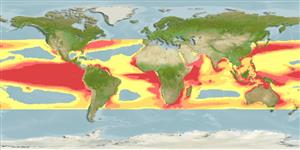Environment: milieu / climate zone / depth range / distribution range
экология
морской; пределы глубины 0 - 100 m (Ref. 12951). Subtropical; 38°N - 34°S
Circumglobal in tropical seas. Indian Ocean: off South Africa, Bay of Bengal, and probably Indonesia (Ref. 9911). Eastern Central Pacific: From Gulf of California to Chile (Ref. 130539).
Length at first maturity / Size / Вес / Возраст
Maturity: Lm 163.6, range 146 - ? cm
Max length : 220 cm WD самец/пол неопределен; (Ref. 2850); common length : 150 cm WD самец/пол неопределен; (Ref. 9256)
Краткое описание
морфология | морфометрия
A moderate-sized devilray with a short head bearing short head fins; dorsal fin white-tipped, and pectoral fins with swept-back tips and a prominent double bend to the front margins; upper disc sparsely covered with small, blunt denticles and tail shorter than disc, with no spine (Ref. 5578). Dark blue to black above; white below, with silvery pectoral fin tips (Ref. 5578). No caudal fin (Ref. 5578).
Occurs in coastal and oceanic waters, but more common near the coast (Ref. 9256). Found singly or in small groups (Ref. 12951). Feeds mainly on planktonic crustaceans (Ref. 12951); mostly small shrimp-like animals (Ref.58048). Ovoviviparous (Ref. 50449). Caught occasionally in the tuna gillnet and in harpoon fisheries. Utilized for its gill filter plates (high value), meat, cartilage and skin (Ref.58048). Can leap out of the water.
Exhibit ovoviparity (aplacental viviparity), with embryos feeding initially on yolk, then receiving additional nourishment from the mother by indirect absorption of uterine fluid enriched with mucus, fat or protein through specialised structures (Ref. 50449). With one large offspring per gestation period. Size at birth 65-85 cm (Ref. 6871).
Last, P.R. and J.D. Stevens, 1994. Sharks and rays of Australia. CSIRO, Australia. 513 p. (Ref. 6871)
Статус Красного Списка МСОП (Ref. 130435)
Угроза для людей
Harmless
Использование человеком
рыболовство: не имеет хозяйственного значения
дополнительная информация
ссылкиаквакультура (рыбоводство)особенности рыбоводствастепень растяжениягенетикаElectrophoresesнаследуемостьболезниобработкаNutrientsMass conversion
инструменты
Специальные отчеты
Скачать в формате XML
ресурсы в Интернет
Estimates based on models
Preferred temperature (Ref.
123201): 21.6 - 29.1, mean 27.8 °C (based on 2652 cells).
Phylogenetic diversity index (Ref.
82804): PD
50 = 0.5005 [Uniqueness, from 0.5 = low to 2.0 = high].
Bayesian length-weight: a=0.01000 (0.00244 - 0.04107), b=3.04 (2.81 - 3.27), in cm total length, based on all LWR estimates for this body shape (Ref.
93245).
Trophic level (Ref.
69278): 3.1 ±0.30 se; based on food items.
устойчивость к внешним воздействиям (Ref.
120179): очень низкий, минимальное время удвоения популяции более 14 лет (Fec=1).
Fishing Vulnerability (Ref.
59153): Very high vulnerability (85 of 100).
Nutrients (Ref.
124155): Calcium = 7.99 [1.05, 135.60] mg/100g; Iron = 0.83 [0.08, 10.24] mg/100g; Protein = 20.6 [15.3, 25.9] %; Omega3 = 0.157 [0.047, 0.501] g/100g; Selenium = 22.8 [4.7, 120.5] μg/100g; VitaminA = 4.56 [0.35, 57.84] μg/100g; Zinc = 0.483 [0.030, 5.484] mg/100g (wet weight);
